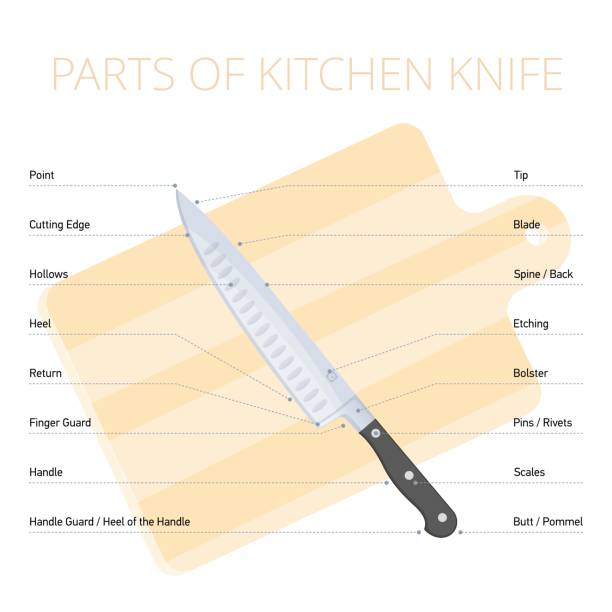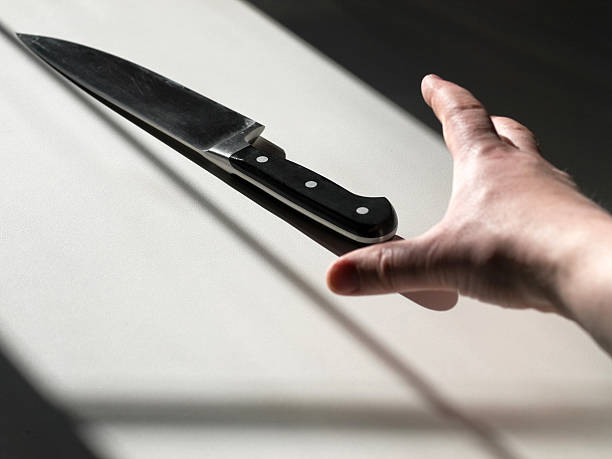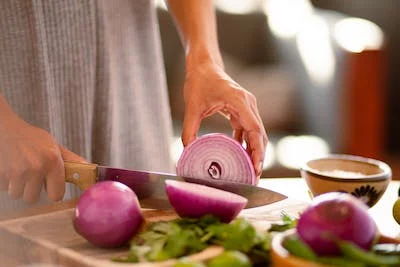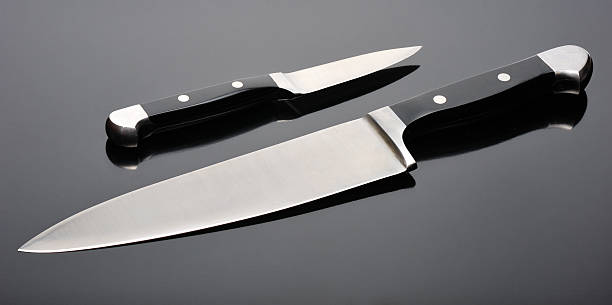The various blade components of a knife each provide a unique function. Those who aren’t knife fans would look at a chef’s knife and see only one tool; we, on the other hand, see so much more. Anyone who wants to learn more about kitchen knives needs to know how they are made and what they are used for. A knife consists of more than simply the handle and the blade, so this refers to the whole thing including the full bolster vs half bolster.
Each knife component has a specific purpose and its own name. The rivet, blade, spinal, foot, and tips, to mention a few. The bolster is an exposed component of various types of kitchen knives. It’s the link between the blade and the grip. However, not everyone is a fan of the bolster, despite its many practical uses and aesthetic benefits.
As we go along with this post, we will be able to cut deeper and learn more about the types of kitchen knives.
Basic Things to Know About Kitchen Knife: Its Designated Parts
If you know how a knife is put together, you’ll have a better idea of what to look for in a kitchen tool.
- You will be able to choose a good knife if you know how its different parts work.
- Investing in a good knife can make cooking more enjoyable.
Though everyone is familiar with the general shape of a knife, not everyone is familiar with the various components that make up said knife or the vocabulary used to describe its anatomy. But regardless of whether you’re talking about a meat cleaver, a hunters’ knife, a pocket knife, or another variety, they all have the same basic features.
Even though there are many different kinds of knives, most of the words used to describe how they are made are the same. You don’t have to be a chef, a knife maker, or a ninja to be able to recognize and name each knife part. On the contrary, if you’re in the market for a new kitchen knife, familiarity with this terminology will aid you in making a well-informed purchase.
Some of the terminology presented here is useful whether you’re shopping for a combat knife or a wooden stick. In order to better understand the knife, we’ll separate it into its two main components: the blades and the handle.
Parts of the Blade
The knife’s blade is the functional end of the tool. This refers to the metal components of the knife, most notably the blade and tang, which protrude from the handle. Of course, there are distinct components to the knife blade, even though the term “blade” is used to describe the entire cutting edge.
Edge
It is the edge of a knife, whether a chef’s knife, a peeling knife, a meat knife, or whatever kind, that does the bulk of the work when cutting. Common chopping, slicing, and mincing tasks can be accomplished using the cutting edge. There are many different types of knives, but no matter what, the edge is always the most vital element of the blade.
The serrated blade of a bread knife, for instance, is better suited than the smooth blade of a chef’s knife for cutting through the tough exterior of bread or other breaded products. In any case, the utility of the blade is essential. How sharp a knife is depends on the beveling or the degree to which the blade is honed to a point. Blades are sharpest when their bevel angle is minimal.
For example, a razor with a sharp edge may not be as sharp as one with a sloped edge. Double beveling, or sharpening on both sides, is a common practice in western kitchen knives. Traditional Japanese knives, such as the santoku, often only have one beveled edge. An important hint and key point: the blade’s pointed tip is exactly what it sounds like.
Spine
Blades have a sharpened edge and a dull spine. The tang is thickest part of this kitchen’s cutting tool, which makes it the most robust component. It is much thicker than the blade. A thick-spined knife is more durable and can withstand more force than a thin-spined knife.
Heel
The section of the knife that fits comfortably in your hand is called the heel. At this point, the knife bends upward into the handle, marking the end of the blade. In order to prevent injury to your hand, the heel’s back end will be left unhoned, just like the spine. An obvious heel is a common feature of kitchen knives. So, you don’t cut yourself by accident, they put a barrier between your palm and the knife. However, other blades, such as steak knives and pocket knives, do not have a heel.
Parts of the Handle
After looking at the blade, it’s time to check out the knife’s other crucial component: the grip.

Tang
When you hold a knife, you’ll feel the tang, which is the joint between the handle and the blade. The tang connects the uncut portion of the blade to the grip. For maximum durability, choose a knife with a full tang, in which the blade continues all the way through to the handle. The metal is continuous from the blade to the handle, so the knife is less likely to break under stress.
A full-tang blade is the most robust option for sharp knives or any other type of heavy-duty knife. If the knife’s handle ends in metal, it’s not a complete tang knife. For the knife to be balanced, the spine must extend from the blade through the handle and out the rear. A knife with a concealed tang will have metal that protrudes through the handle, while a standard knife will not.
Rivets
Small but vital, the rivets secure the blade to the handle. While rivets exist in a variety of forms, they always have the same purpose: to hold your knife together. To put it bluntly, a knife without a handle is useless in the kitchen.
Scales
In a full-tang knife, the handle is made of scales, which can be anything from wood to plastic to steel. The material used in the handle of a kitchen knife should be one that is easy to hold onto and won’t slip while in use. It’s especially important to keep your hands away from the blade when the knife’s handle is wet, as it often is in a kitchen due to the frequent washing of produce, hands, and other food items.
Pommel
That part of a knife that isn’t the point is called the pommel or butt. Even though it’s not used frequently in the kitchen, it’s important that whatever form it takes be sturdy. To improve grip, the pommel should protrude slightly at the very tip.
Bolster
Strengthening the knife at the point where the blade and handle meet, the bolster is positioned there. However, some designs of bolsters might make it hard to use an electric knife sharpener. In some cases, the knife’s bolster acts as a separator between the blade and the grip. Many Western-style knives have a bolster, but some manufacturers are adding them to Japanese-style knives.
They changed the shape of the bolster to make a hybrid design. By resting your hand on the bolster, you may put a lot of force on the blade without risking injury or damage to the knife. Keep in mind that the verb form of “bolster” is to strengthen; this is also true with kitchen knives.
Types of Bolsters on Kitchen Knives: Full Bolster vs Half Bolster
If you want a knife that has a bolster, you can choose between two main types, each of which has its own set of pros and cons. See below the difference of the full bolster vs half bolster:
1-Full Bolster
In kitchen knives, the bolster is often full-length and goes all the way to the blade’s heel. The finger guard is the result of this continuation. Because it acts as a stopper, fingers are safer because they can’t slide beneath the blade. During the forging process, the finger guard can also grow on its own, but it usually stops short of the heel of the blade. Therefore, a finger guard can be used in place of a full bolster.
2-Half Bolster
Half bolsters, as their name implies, are half the size of full bolsters and are hence less common. The shorter length of the guard makes the hand-to-blade transfer more natural. The blade is easier to sharpen due to the semi-shape. If you want to sharpen the blade yourself with simple tools, you should choose a kitchen knife with a semi-bolster.
Half bolsters, on the other hand, typically lack a finger guard, which may lead one to believe that they are less secure. If the knife is held by someone with enough training and experience, there is no need for a finger guard.
Can Knives Benefit from a Full Bolster vs Half Bolster?
The knife structure in the midst of the handle and the knife’s blade is called the bolster, whether it is full bolster vs half bolster. It’s a sturdier piece of the knife that may be cast in the same metal as the rest of the blade or added later. Its modular design allows it to be built from a wide range of materials, including metal, bone, and hard, dense wood. The material of the bolster is usually chosen based on how it works, how the blade is made, and how the handle is made.
What is the Function of a Bolster?
Regardless if the knife has a full bolster vs half bolster, the bolster’s function as follows:
1-Improving the Knife’s Usability
The balance of a knife can be improved by adding a bolster, which gives the blade more weight. Therefore, the balance permits the blade to be handled with greater dexterity and accuracy. With this improved grip, you’ll be able to work more efficiently. The transition from the knife’s blade to its handle is seamless thanks to the bolster. It gives the blade added durability. The blade of most knives is considerably lighter than the grip.
2-Guarantees Your Safety
A knife’s bolster keeps the user and other people from getting cut by accident. If the knife blade breaks while you’re using it, the sheath will shield you from danger.
3-Adds to the knife’s longevity
This is where most knives break: where the handle meets the blade. When the knife gets this dull, it’s bound to snap. With the help of a bolster, you may rest assured that nothing will ever snap in that spot. The bolster adds even more strength to the knife by making it more balanced.
4-Increases the Level of Coziness and Class
A polished mirror finish on a brass bolster gives the knife an extra elegant look when used as a bolster. The bolster is also a soft spot to rest your thumbs.
Supporting Elements
Metal, plastic, and even wood are all suitable materials for knife bolsters.
Steel

To this day, metal remains the go-to material for bolster construction. Bolsters can be purchased in three different metals: steel, aluminum, and brass. Metal bolsters are preferred by most bladesmiths because they are durable, improve balance, and are simple to polish.
The forged blades and metal bolsters are made from a certain piece of metal. Metal reinforcements are also laser-cut and stamped for use. Metal bolsters last a long time, which is a major benefit. Bolsters made of metal that were forged along with the blade add stability.
Polycarbonate
Some producers pad the knife with polyethylene to keep hands safe from the blade. Slim and lightweight, plastic bolsters are great for folding knives and other blades that need to be carried around frequently. Because the material might not be well balanced, it can’t be used to make big blades.
Lumber
Outdoor and hunting knives benefit greatly from having wooden bolsters. Aside from serving as a stabilizer, wood’s coarse grain makes it easy to grasp. If you go with a wooden bolster, make sure to give the blade a thorough cleaning in the area.
Full Bolster vs Half Bolster: How Does a Knife Bolster Work?
The blades and handles of knives are joined together at the bolster. The tang is the section of metal that connects the tip of the handle to the base of the blade. A bolster is not standard equipment for blades. Some chefs find it indispensable, while others prefer or perhaps require a bolstered knife. But it’s not clear whether or not the bolster actually helps the knife last longer.

A high-quality kitchen knife is made from a single piece of steel, which is shown by the fact that it has an integral bolster. The bolster isn’t the sole indicator of quality, though. The industrial industry of today continually improves. When looking for a good knife for the kitchen, there are some other considerations to keep in mind.
Most knives that are meant to be pushed through something with a lot of pressure on the tip have a bolster to protect the blade. The purpose of the bolster is to stop the user’s hand from sliding forward over the blade and cutting themselves.
Give a Counterexample
There can be a big difference between the weight of the knife’s blade and that of its handle, especially if the handle is made of a lighter material.
Strengthen the Grasp
The bolster of a knife strengthens the middle part of the blade, making it easier to hold in some situations. A bolster adds weight to the area around the blade where the user’s fingers will be when pinching the knife, improving the user’s grip.
Avoid Having your Fingers Go Forward and Get Cut
Most knives that are meant to be pushed through something with a lot of pressure on the tip have a bolster to protect the blade. The purpose of the bolster is to stop the user’s hand from sliding forward over the blade and cutting themselves. A finger guard is sometimes built into the bolster to make it safer for the person using it.
As a Safeguard for Knives’ Handles
For some knives, the bolster serves more to safeguard the handle than the user. If the handle is made of a material that is likely to break during installation or while it is being used, a bolster may be put in front of it.
Enhancement to the Visual Appeal
The bolster on certain knives is there only for aesthetic reasons, and not for any practical use. In this situation, the bolster is typically made from a lightweight material like bone, horn, or gorgeous hardwood.
What Makes a Good Bolster?
Knives with bolsters are not for everyone, so be picky if you decide to go that route. Whatever bolster style you go with, full or half, there shouldn’t be any room between the grip and the cutting edge. A blade’s bolster should be integral to the blade itself, not an added “collar.” The one that is perfect on your grip is the best one to go.
Bolstering a Knife or Not?
To use or not to use a knife with a bolster is up to personal preference. The two may not be equally liked by all cooks. Others, based on the specifics of the task given, may opt for either. As you look for a new knife, it’s important to think about the tool as a whole. It’s best to examine the blade’s thickness, tang, length, and balance.
If your knife has a full bolster, it might be harder to sharpen, so keep that in mind. The blade’s intended use is another crucial factor to think about. As we’ve seen, a stuffed bolster can make it difficult to do even the most basic of kitchen chores. However, this prop works best for more difficult endeavors.
Full Bolster vs Half Bolster: Which One to Choose?

Due to the full bolster, the knife’s center of gravity has been shifted to the grip. It takes more force to push with a knife that is balanced in this way. You’ll need to put more force on the blade when using this knife. With a half bolster, though, you have more leeway in how you hold the blade than you would with a complete one.
Cutlery with half bolsters is more portable because of its reduced size. There is little discernible distinction between full and half bolsters. It ultimately depends on the user’s preferences. None of the available aid options are better. Instead, it comes down to what you prefer.
Why Do Some Knives Don’t Possess a Bolster?
While some knives do feature a bolster, many do not. When making a knife, the bolster is not always necessary. This could be because the knife doesn’t need one or because the maker wants to highlight the blade’s other features. When a knife has a bolster, especially one that protects your fingers, it can be hard to sharpen.
If the blade was made so that it had to be sharpened all the way to the heel, the support might be thinner or not there at all. When used for what they were made for, knives made for precision work and clean cuts don’t usually need a lot of force.
Frequently Asked Questions:
Q: What happens if a blade is sharpened to an excessive degree?
The rim is becoming more robust. Over time, the area behind the primary bevel will thicken and take on a wedge shape. No matter how sharp the blade is on the inside, a wedge shape will make it feel dull when cutting. For this reason, every time you sharpen the blade, you should shave off a tiny bit of material.
Q: How do you define a double bolster?
The most noticeable distinction between the two is the twin bolster design of the former, which features a bolster beneath the blade and another at the base of the latter’s handle.
Q: When talking about knives, what exactly does “bolster” refer to?
Protecting the user’s fingers from the knife’s blade while also increasing the level of comfort provided by the handle is the primary function of the bolster. Bolsters aren’t standard on every knife. The handle may be crafted from a number of different materials and may be molded or riveted.
Cutting Up
Your kitchen knife would be incomplete without the bolster. In addition to improving the knife’s overall quality and making it easier to use, it also serves as an extra layer of protection. A well-forged knife will have a bolster that is the core component of the blade instead of a different “collar.”
You can get knives with either a half or full bolster, and the decision should be made based on how you plan to use the blade. Plenty of materials, including wood, metal, and plastic, are available as well. Consider the knife’s intended purpose while making your bolster selection.
